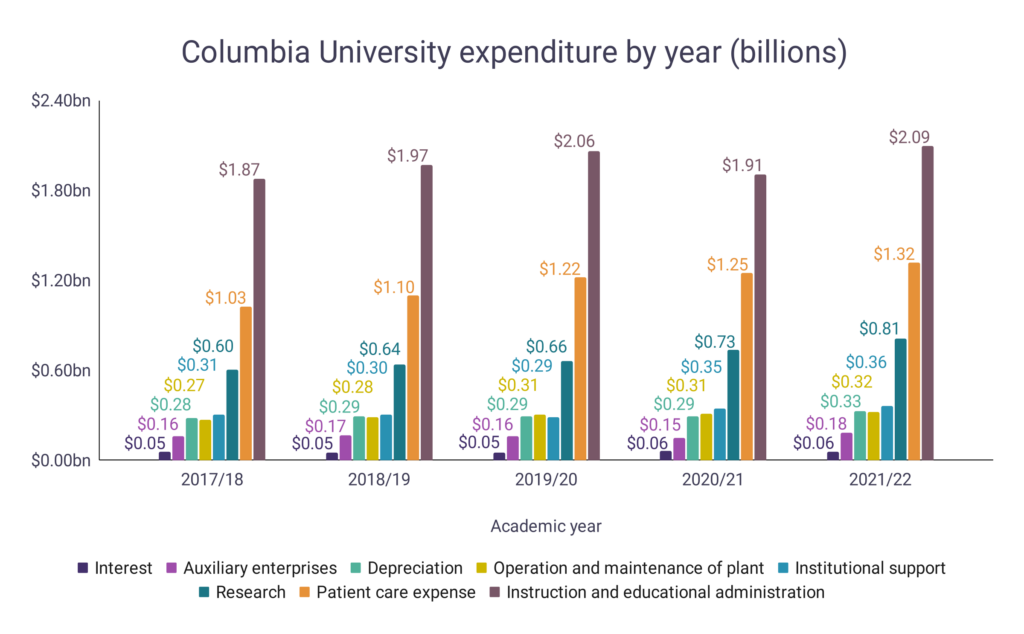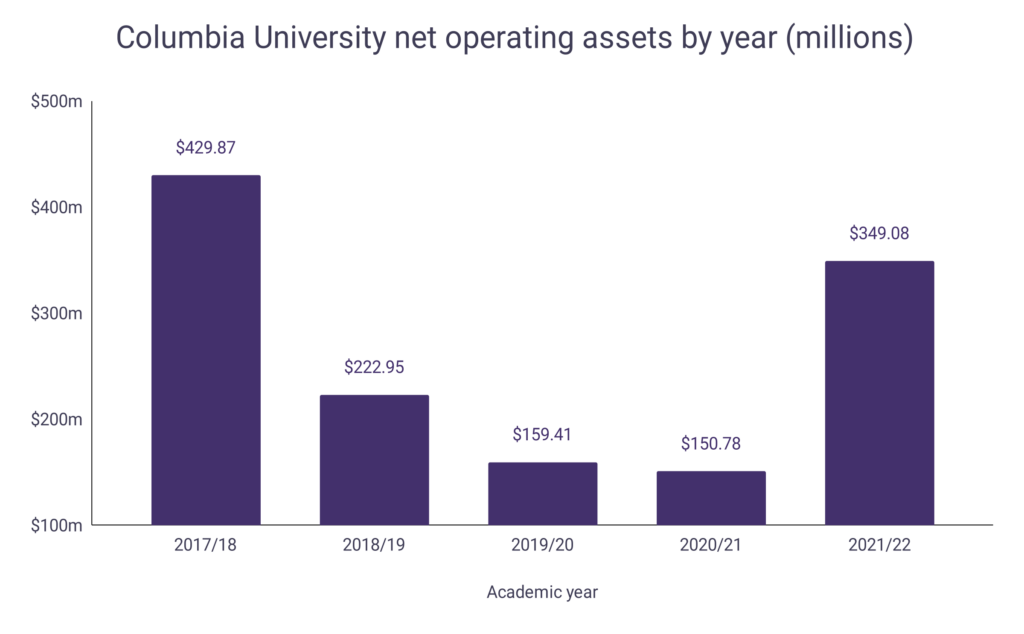This analysis examines the finances of Columbia, focusing on revenue, expenditure and net operating assets. Although Columbia’s revenue has been on an upward trajectory, it is important to note that its expenses have also risen.
- As of the 2021/22 academic year, Columbia University generated $5.83 billion in revenue.
- Total revenue has increased by 12.16% since the $5.20 billion generated in 2020/21.
- Over the given 5-year period, Columbia’s revenues increased by 16.51%.
- $1.51 billion was generated through patient care revenue (25.94% of the total revenue).
- $1.47 billion was generated through tuition and fees (25.21% of the total revenue).
- In total, Columbia University had expenses of $5.48 billion.
- Total expenses have increased by 8.60% since the $5.04 billion spent in 2020/21.
- $2.09 billion was spent on instruction and educational administration (38.21% of the overall spend).
- $1.32 billion was spent on patient care expenses (24.05% of the overall spend).
- From the given data, Columbia made a net operating asset gain of $349.08 million for the year.
Total Columbia University revenue
Columbia University relies primarily on patient care revenues as its main source of income. Furthermore, the university generates substantial revenue from tuition fees and government grants.
- As of the 2021/22 academic year, Columbia University generated $5.83 billion in revenue.
- Total revenue has increased by 12.16% since the $5.20 billion generated in 2020/21.
- Over the given 5-year period, Columbia’s revenues increased by 16.51%.
- $1.51 billion was generated through patient care revenue.
- Patient care revenue made up 25.94% of the total revenue.
- $1.47 billion was generated through tuition and fees.
- Tuition and fees made up 25.21% of the total revenue.
- $1.21 billion was generated through government grants and contracts.
- Government grants and contracts made up 20.81% of the total revenue.
| Revenue type | 2017/18 | 2018/19 | 2019/20 | 2020/21 | 2021/22 | Change vs 2020/21 |
| Tuition & fees | $1.15 billion | $1.20 billion | $1.24 billion | $1.14 billion | $1.47 billion | +29.06% |
| Government grants & contracts | $0.93 billion | $0.96 billion | $1.02 billion | $1.10 billion | $1.21 billion | +10.66% |
| Private gifts, grants & contracts | $0.65 billion | $0.48 billion | $0.59 billion | $0.57 billion | $0.57 billion | -0.20% |
| Other educational & research activities | $0.23 billion | $0.24 billion | $0.22 billion | $0.20 billion | $0.22 billion | +8.49% |
| Patient care revenue | $1.24 billion | $1.30 billion | $1.31 billion | $1.48 billion | $1.51 billion | +2.12% |
| Investment income & gains utilized | $0.62 billion | $0.66 billion | $0.66 billion | $0.61 billion | $0.64 billion | +6.06% |
| Sales & services of auxiliary enterprises | $0.18 billion | $0.19 billion | $0.16 billion | $0.10 billion | $0.20 billion | +100.68% |
| Total | $5.00 billion | $5.03 billion | $5.20 billion | $5.20 billion | $5.83 billion | +12.16% |
A graph is given below to show Columbia’s revenue by year:

Total Columbia University expenditure
Columbia has seen consistent increases in overall expenditure. The largest percentage of the institution’s spending is for instruction and educational administration.
- As of the 2021/22 academic year, Columbia University had expenses of $5.48 billion.
- Total expenses have increased by 8.60% since the $5.04 billion spent in 2020/21.
- Over the given 5-year period, Columbia’s expenses increased by 19.83%.
- $2.09 billion was spent on instruction and educational administration.
- Instruction and educational administration made up 38.21% of the overall spend.
- $1.32 billion was spent on patient care expenses.
- Patient care expenses made up 24.05% of the overall spend.
- $0.81 billion was spent on research.
- Research made up 14.83% of the overall spend.
| Expense type | 2017/18 | 2018/19 | 2019/20 | 2020/21 | 2021/22 | Change vs 2020/21 |
| Instruction & educational administration | $1.87 billion | $1.97 billion | $2.06 billion | $1.91 billion | $2.09 billion | +9.86% |
| Research | $0.60 billion | $0.64 billion | $0.66 billion | $0.73 billion | $0.81 billion | +10.68% |
| Patient care expenses | $1.03 billion | $1.10 billion | $1.22 billion | $1.25 billion | $1.32 billion | +5.69% |
| Operation & maintenance of plant | $0.27 billion | $0.28 billion | $0.31 billion | $0.31 billion | $0.32 billion | +3.01% |
| Institutional support | $0.31 billion | $0.30 billion | $0.29 billion | $0.35 billion | $0.36 billion | +4.41% |
| Auxiliary enterprises | $0.16 billion | $0.17 billion | $0.16 billion | $0.15 billion | $0.18 billion | +24.81% |
| Depreciation | $0.28 billion | $0.29 billion | $0.29 billion | $0.29 billion | $0.33 billion | +13.26% |
| Interest | $0.05 billion | $0.05 billion | $0.05 billion | $0.06 billion | $0.06 billion | -5.56% |
| Total | $4.57 billion | $4.81 billion | $5.04 billion | $5.04 billion | $5.48 billion | +8.60% |
A graph is given below to show Columbia’s expenditure by year:

Total Columbia University net operating assets
- As of the 2021/22 academic year, Columbia made a net operating asset gain of $349.08 million.
- Columbia’s highest increase over the given period was during 2017/18 ($429.87 million).
- Large reductions were seen during the academic years of 2019/20 and 2020/21.
- The financial impacts of the pandemic during these periods appear to have greatly affected revenue streams and expenditure.
- Columbia saw average annual net operating assets increases of $262.42 million during the 5-year period.
| Academic year | Total net operating assets |
| 2017/18 | +$429.87 million |
| 2018/19 | +$222.95 million |
| 2019/20 | +$159.41 million |
| 2020/21 | +$150.78 million |
| 2021/22 | +$349.08 million |
A graph is given below to show Columbia’s net operating assets by year:

Columbia revenue FAQ
Where does Columbia University’s funding come from?
- Columbia’s funding predominantly comes from:
- Patient care revenue.
- Tuition and fees.
- Government grants and contracts.
What are Columbia University’s main expenses?
- Columbia’s main expenses include:
- Instruction and educational administration.
- Patient care expenses.
- Research.
Is Columbia University for profit?
- Columbia University is a private, not-for-profit Ivy League college that reinvests its revenue into the institution.
- The reinvested revenue supports various areas including operations, salaries, resources and student services.
- Its primary goal is to fulfill educational aims through the allocation of these funds.

